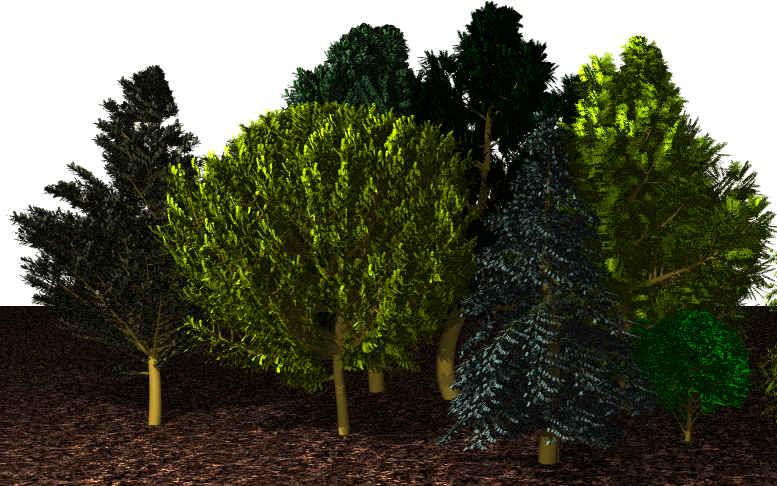PhD proposal
Virtual plant: procedural reconstruction mixing incomplete geometric
data and a priori knowledge
 |
To apply, see here (and contact us!).
Advisors
| Marie-Paule Cani | Franck Hétroy |
| LJK/EVASION | LJK/EVASION |
| E-mail : Marie-Paule.Cani@imag.fr | E-mail : Franck.Hetroy@imag.fr |
| Tel. : 04 76 61 54 32 | Tel. : 04 76 61 55 04 |
Context
Automatic digitizing of vegetal structures is a current critical barrier for the study of plant growth and functioning [SR97, GS05] in different research domains such as computer graphics, biology and agronomy. Recent apparition of laser scanners makes it possible to acquire precise point cloud representations promising new acquisition schemes. However, this data is often both noisy and incomplete, due to occlusions. Based on 3D laser scanner observation of plant branching systems and canopies, the goal of the thesis is to construct a high-level, detailed, geometrical model of the plant with sufficient accuracy for agronomical applications. Both branching systems with and without leaves will be considered, each one requiring dedicated techniques.
Objectives
The thesis will focus on topological correctness of the branching
system, using a priori botanical knowledge and topological skeletons
[AHLD07] to overcome these problems. Data and botanical background on
plant structures will be given by collaborators from Virtual Plants (INRIA
joint team with CIRAD and INRA), who already worked with us on a sketch-based
approach for tree design [WBCG09]. Several possible solutions will then
be studied to generate the plant's local geometry from the topological
skeletons, including convolution implicit surfaces [AC02, HAC03], which
seem particularly adapted for such branching structures.
Reconstruction of a complete branching system with leaves is more complex, since most of the inner leaves cannot be visible from a laser scan. Thus, the reconstruction should first distinguish between areas in the input point clouds corresponding to wood and leaf parts of the plant. Then, the previous approach will be used for the wood part, while leaves need to be reconstructed differently.
Pre-requisites
Required skills include computer graphics and geometric modeling techniques,
with an emphasis on surface modeling and processing.
Technical skills include C++, OpenGL and Qt programming.
Interest for biology and agronomy will be a plus.
Keywords : virtual plant, reconstruction, skeleton, implicit surface.
References
- [AC02] A. Angelidis and M.-P. Cani. Adaptive Implicit Modeling using Subdivision Curves and Surfaces as Skeletons. In 7th ACM Symposium on Solid Modeling and Applications. ACM, Saarbrucken, Allemagne, juin 2002. pages 45-52. ACM, 2002.
- [AHLD07] G. Aujay, F. Hétroy, F. Lazarus, and C. Depraz. Harmonic skeleton for realistic character animation. In ACM-EG Symposium on Computer Animation, San Diego, USA, 2007.
- [GS05] C. Godin and H. Sinoquet. Functional-structural plant modelling. New Phytologist, 166 :705-708, 2005.
- [HAC03] S. Hornus, A. Angelidis and M.-P. Cani. Implicit Modelling Using Subdivision curves. Visual Comput., 19 (2-3), 94-104, 2003.
- [PL90] P. Prusinkiewicz, A. Lindenmayer, The Algorithmic Beauty of Plants, Springer-Verlag, 1990.
- [SR97] H. Sinoquet and P. Rivet. Measurement and visualisation of the architecture of an adult tree based on a three-dimensional digitising device. Trees: Structure and Function, 11 :265-270, 1997.
- [WBCG09] J. Wither, F. Boudon, M.-P. Cani and C. Godin. Structure from silhouettes: a new paradigm for fast sketch-based design of trees. Comp. Graph. Forum (Proceedings of Eurographics), 28 (2), 2009.